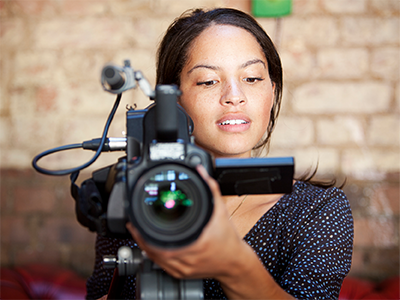Legal Videography: Changing the Means Evidence is Recorded and Presented
Legal Videography: Changing the Means Evidence is Recorded and Presented
Blog Article
Exploring the Devices of Legal Videography: Introduction Its Procedure in Shielding Genuine Aesthetic Statement for Judicial Proceedings
In the world of judicial procedures, the role of lawful videography stands as a cornerstone in maintaining and providing aesthetic proof. As technology remains to development, the systems behind legal videography have actually ended up being significantly elaborate, supplying an essential layer of authenticity to testaments recorded on video clip. By diving into the functional details of lawful videography, one can uncover the precise processes that safeguard the integrity of aesthetic proof presented in courtrooms - Legal Videography. This expedition not only drops light on the historic evolution of legal videography however likewise means the future trends that may further reinvent how visual statements are upheld in the realm of justice.
Historic Advancement of Legal Videography
Examining the historic progression of lawful videography exposes a considerable makeover in the recording and presentation of visual proof within the lawful landscape. In the past, lawful procedures greatly relied upon written records and pictures to record events and offer proof. Nonetheless, with the arrival of video clip innovation, the legal market saw a paradigm shift in how visual testimony was caught and presented.
The development of legal videography can be traced back to the late 20th century when innovations in video recording tools made it more available for usage in courtrooms. This technical development not only improved the accuracy and reliability of visual evidence however also reinvented the means cases existed to discretionary (Legal Videography). Lawyers began to acknowledge the convincing power of video recordings in sharing emotions, nuances, and non-verbal cues that created records or photographs alone could not record successfully

Modern Technology Improvements in Video Clip Documentation
What essential technological improvements have transformed video clip documents in the lawful area? The legal area has actually seen considerable improvements in video documentation innovation that have boosted the credibility and reliability of visual evidence in judicial process. Among the essential improvements is high-definition (HD) video clip recording capabilities, which provide crystal-clear pictures and sharp information that are essential for properly recording testimonies, facial expressions, and other aesthetic hints. In addition, the assimilation of timestamping and metadata features in video clip paperwork tools has actually enabled exact paperwork of when and where the video clip was tape-recorded, making certain the stability of the evidence offered in court.
Additionally, innovations in video encryption and watermarking modern technologies have actually reinforced the security and tamper-proof nature of video clip evidence, protecting it against unauthorized changes or tampering. In addition, the development of cloud storage space services and remote gain access to capabilities has streamlined the storage space, retrieval, and sharing of video clip evidence, helping with seamless cooperation among lawyers and guaranteeing reliable access to vital visual statements when needed. These technical developments in video documents have actually most certainly changed the lawful field, boosting the precision, integrity, and admissibility of aesthetic evidence in judicial procedures.
Duty of Lawful Videographers in Court Room Settings
The advancement of video clip documents modern technology in the lawful field has necessitated a crucial duty for legal videographers in court settings, ensuring the integrity and reliability of aesthetic statements provided during judicial proceedings. Legal videographers play an essential function in capturing and protecting accurate aesthetic evidence that can be crucial in court situations. Their responsibility reaches establishing up devices, tape-recording procedures, and producing high-grade video clips that properly show the occasions in the courtroom.
In courtroom settings, legal videographers have to comply with rigorous guidelines and standards to maintain the authenticity of the visual record. They have to have a keen eye for detail and an extensive understanding of lawful procedures to make certain that the footage they record is a true representation of the events that transpired. Furthermore, legal videographers usually work closely with lawful groups to make certain that the video clip proof aligns with the situation's requirements and can be efficiently presented in court to support the lawful debates being made. In general, the role of legal videographers in court setups is crucial in promoting the concepts of justice use this link and ensuring the openness of legal proceedings.

Ensuring Admissibility and Stability of Video Evidence
To preserve the reputation of aesthetic proof presented in lawful procedures, guaranteeing the admissibility and honesty of video clip proof is an essential responsibility for legal videographers. Admissibility refers to the acceptance of evidence by the court, and for video proof to be acceptable, it needs to fulfill certain criteria. Lawful videographers play an important duty in making certain that the video clips they capture adhere to the policies of proof, such as reliability, authenticity, and importance.
Integrity of video clip proof involves maintaining the originality and accuracy of the video from the moment it is videotaped up until it exists in court. This consists of securely keeping the video data, recording the chain of custodianship, and a fantastic read preventing any kind of meddling or changes. Legal videographers should stick to stringent protocols to assure the honesty of the video proof and avoid any type of difficulties to its credibility.
Future Trends in Legal Videography
Offered the raising reliance on innovation in legal process, lawful videographers are poised to accept ingenious improvements shaping the future of visual statement capture and discussion. Among the noticeable fads coming up is the integration of online fact (VR) and augmented reality (AR) innovations into lawful videography. These innovations have the possible to reinvent how aesthetic proof is presented in courts, enabling juries and judges to submerse themselves in the scene of the criminal activity or event.
Furthermore, using expert system (AI) formulas for video clip evaluation is expected to simplify the procedure of evaluating and examining large amounts of video clip footage. AI can help in recognizing key moments, anomalies, and patterns within videos, improving the effectiveness of legal examinations.

Conclusion
Finally, legal videography has actually played an essential function in supplying genuine aesthetic evidence for judicial proceedings. Through technological advancements and the knowledge of legal videographers, the stability and admissibility of video proof are guaranteed in courtroom setups. As lawful videography continues to evolve, it will certainly be important to maintain standards that maintain the accuracy and integrity of aesthetic testament for the future of lawful proceedings.
Analyzing the historical development of lawful videography reveals informative post a substantial improvement in the catching and presentation of aesthetic evidence within the lawful landscape.The development of video documentation innovation in the lawful field has required a critical role for legal videographers in court settings, making sure the honesty and integrity of visual testimonies provided throughout judicial procedures. Furthermore, legal videographers usually work closely with lawful groups to guarantee that the video clip proof aligns with the case's demands and can be successfully presented in court to support the legal debates being made.To keep the trustworthiness of visual proof provided in legal proceedings, ensuring the admissibility and stability of video proof is a crucial responsibility for lawful videographers. As lawful videography proceeds to progress, it will be vital to promote requirements that keep the accuracy and dependability of visual statement for the future of legal procedures.
Report this page